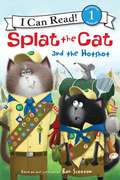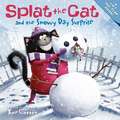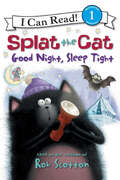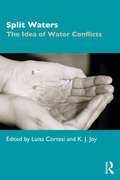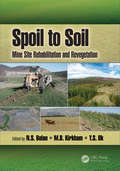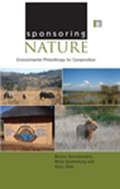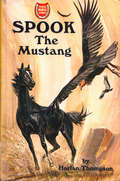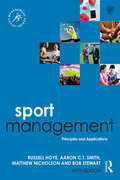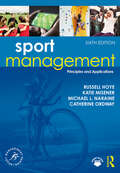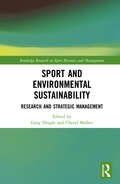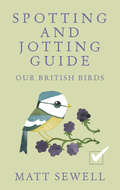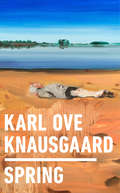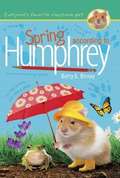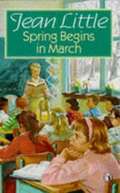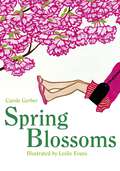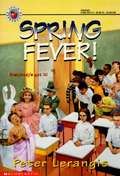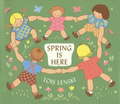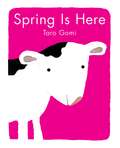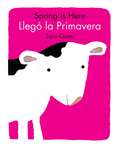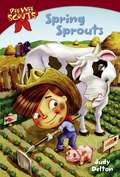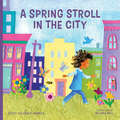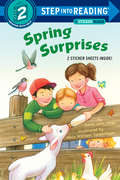- Table View
- List View
Splat the Cat and the Hotshot (I Can Read Level 1)
by Rob ScottonSplat goes on a Cat Scouts trip in this hilarious I Can Read book from New York Times bestselling author-artist Rob Scotton. Splat can hardly wait to put on his uniform, tie knots, and build a fire. But when a new member of the group does everything just a bit better than everyone else, Splat wishes he could have a chance to shine. Thanks to some sticky mud, he might get to show what a great outdoors-cat he really is!Beginning readers will practice the -ot sound in this easy-to-read addition to the Splat series. Splat the Cat and the Hotshot is a Level One I Can Read book, which means it's perfect for children learning to sound out words and sentences.
Splat the Cat and the Snowy Day Surprise (Splat the Cat)
by Rob ScottonIn this book, Splat the cat alongwith his friend goes through a day of fun as the snow falls.
Splat the Cat: Good Night, Sleep Tight (I Can Read Level 1)
by Rob ScottonJoin Splat the Cat in this funny story about an unlikely camp friendship from New York Times bestselling author and artist Rob Scotton. Splat is really excited about going camping—until his mom tells him she has invited his rival, Spike.Will Spike ruin Splat's trip? Or maybe Splat will learn that his worst enemy isn't so different from him after all…Splat the Cat: Blow, Snow, Blow is a Level One I Can Read book, which means it’s perfect for children learning to sound out words and sentences. Whether shared at home or in a classroom, the short sentences, familiar words, and simple concepts of Level One books support success for children eager to start reading on their own. Beginning readers will love this hilarious addition to the Splat series that features the long -i sound.
Split Waters: The Idea of Water Conflicts
by K. J. Joy Luisa CortesiLimited, finite, contaminated, unavailable or expensive, water divides people all around the globe. We all cannot do without water for long, but can for long enough to fight for it. This commonsensical narration of water conflicts, however, follows a pattern of scarcity and necessity that is remarkably unvaried despite different social and geographical contexts. Through in-depth case studies from around the globe, this volume investigates this similarity of narration—confronting the power of a single story by taking it seriously instead of dismissing it. In so doing, it invites the reader to rethink water conflicts and how they are commonly understood and managed. This book: Posits the existence of the idea of water conflict, and asks what it is and what it produces, thus how it is used to pursue particular interests and to legitimise specific historical, technological and environmental relations; Examines the meaning and power of ideas as compared to other categories of knowledge, advancing theoretical frameworks related to environmental knowledge, discursive power, social constructivism; Presents an alternative agenda to deepen the conversation around water conflicts among scholars and activists. Of interest to scholars and activists alike, this volume is addressed to those involved with environmental conflicts, environmental knowledge and justice, disasters and climate change from the disciplinary angles of environmental anthropology and sociology, political ecology and economy, science and technology studies, human geography and environmental sciences, development and cooperation, public policy and peace studies. Essays by Gina Bloodworth, Ben Bowles, Patrick Bresnihan, Luisa Cortesi, Mattia Grandi, K. J. Joy, Midori Kawabe, Adrianne Kroepsch, Vera Lazzaretti, Leslie Mabon, Renata Moreno Quintero, Madhu Ramnath, Jayaprakash Rao Polsani, Dik Roth, Theresa Selfa,Veronica Strang, Mieke van Hemert, Jeroen Warner, Madelinde Winnubst.
Spoil to Soil: Mine Site Rehabilitation and Revegetation
by N. S. Bolan M. B. Kirkham Y. S. OkSpoil to Soil: Mine Site Rehabilitation and Revegetation presents both fundamental and practical aspects of remediation and revegetation of mine sites. Through three major themes, it examines characterization of mine site spoils; remediation of chemical, physical and biological constraints of mine site spoils, including post mine-site land-use practices; and revegetation of remediated mine site spoils. Each theme includes chapters featuring case studies involving mine sites around the world. The final section focuses specifically on case studies with successful mine site rehabilitation. The book provides a narrative of how inert spoil can be converted to live soil. Instructive illustrations show mine sites before and after rehabilitation. The purpose of this book is to provide students, scientists, and professional personnel in the mining industry sensible, science-based information needed to rehabilitate sustainably areas disturbed by mining activities. This book is suitable for undergraduate and graduate students majoring in environmental, earth, and soil sciences; environmental and soil scientists; and mine site environmental engineers and regulators.
Spoiled Rotten America: Outrages of Everyday Life
by Larry MillerLike Kofi Annan, Larry Miller is one of the most irresistible comic personalities working today. Known for years as an actor, writer, comedian, and sexual pioneer, he's gained a new following as a cultural commentator and frequent guest on political shows. Now, in Spoiled Rotten America, he fixes his gaze on what's funny about our daily lives—which includes, roughly speaking, everything. From middle-aged drinking ("When you're in your twenties, you can drink all night and bungee-jump off a bridge the next day. If I drank all night, I'd want to go off that bridge without the cord") to the excesses of our eating habits ("This is why the world hates us: the size of the portions we order. Thank God they've never shown us eating on Al Jazeera—that would be the end of it"), Miller finds the silver lining of absurdity within every black cloud.Ultimately, though, Spoiled Rotten America is more than just the average yukfest. It's an insightful, and surprisingly heartfelt, plea for us to notice what's best and worst about ourselves. "The American pendulum only swings to extremes," he writes. "The news is on all day, but we know less and less; there's music in every mall, but we don't hear it; everyone has a phone but nothing to say. The chubbiest of us have the strictest diets, because we can't learn to modulate and moderate. It's all or nothing. One bite of a cookie, and suddenly you're on a plane to Vegas with a hooker. To the Cranky Nitpickers of America—a club I'd join in a second if I weren't already its president—it's long been understood that the world is going to Hell in a handbasket."What better time for a collection of seventeen comic essays?"What better time indeed.
Sponsoring Nature: Environmental Philanthropy for Conservation
by Maano Ramutsindela Harry Wels Marja SpierenburgSaving the world's flora and fauna, especially high-profile examples such as chimpanzees, whales and the tropical rain forests, is big business. Individuals and companies channel their resources to the preservation of nature through various ways, one of which is the funding of environmental non-governmental organizations (ENGOs) and community-based organizations (CBOs). This book is the first to comprehensively address this issue and focus on a dominant theme in environmental philanthropy, the links between ENGOs and CBOs and their sponsors, especially the private sector. It has been argued that donor support is based on recipient's perceived expertise and needs, with no favouritism of flagship environmental organizations as recipients of donor funds. A counterview holds that the private sector prefers to fund mainstream ENGOs for environmental research and policy reforms congenial to industrial capital. The authors show that the debate about these arguments, together with the empirical evidence on which they are based, may shed light on certain aspects of the nature of environmental philanthropy. The book evaluates practical examples of environmental philanthropy from Africa and elsewhere against philosophical questions about the material and geographical expressions of philanthropy, and the North-South connections among philanthropists and ENGOs and CBOs.
Spook the Mustang (Famous Horse Stories)
by Harlan ThompsonSeventeen-year-old David and his parents arrive in California, broke, sick and hopeless, to find Grandy, the family patriarch, missing. This is the exciting, frightening, and heartwarming story of David’s efforts to make Grandy’s ranch workable, help his father recover from a nervous breakdown, calm and train the little black colt he rescued from condors when his mother was killed by lightning, and find Grandy.
Sport Facility Management: Organizing Events and Mitigating Risks
by Mark S. Nagel Richard M. Southall Robin E. AmmonSport Facility Management: Organizing Events and Mitigating Risks, 4th Edition, examines what it takes to successfully operate and manage a sport facility. Veteran authors Robin Ammon, Richard Southall, and Mark Nagel provide a framework for the successful operation of sport and event venues through proven strategies and techniques, as highlighted through salient industry examples. Chapters in this edition explore the complex rules and relationships of public and private financing and ownership, the management of facility revenues and expenses, pricing strategies at the box office, approaches to booking and scheduling, best practices in leveraging human resources, as well as an understanding of and adherence to laws and regulations governing and affecting facilities, employees, and the public through venue contracts, risks, liability, negligence, crowd and alcohol management, as well as emergency planning.
Sport Management: Principles and Applications (Sport Management Series)
by Bob Stewart Matthew Nicholson Russell Hoye Aaron C.T. SmithNow available in a fully revised and updated fifth edition, Sport Management: Principles and Applications tells you everything you need to know about the contemporary sport industry. Covering both the professional and nonprofit sectors, and with more international material than any other introductory sport management textbook, it focuses on core management principles and their application in a sporting context, highlighting the unique challenges of a career in sport management. The book contains useful features throughout, including conceptual overviews, guides to further reading, links to important websites, study questions, and up-to-date case studies showing how theory works in the real world. It covers every core functional area of management, including: Strategic planning Financial management Organizational culture and design Human resource management Leadership and governance Marketing and sponsorship Performance management Sport and the media. The fifth edition includes expanded coverage of sport for development, analytics, monitoring and evaluation, ethics, risk management, sport and health, social media, sustainability, and other contemporary management issues. Complemented by a companion website offering additional resources for students and instructors, this is an ideal textbook for first and second year students in sport management degree programs and for business students seeking an overview of applied sport management principles.
Sport Management: Principles and Applications (Sport Management Series)
by Russell Hoye Katie Misener Catherine Ordway Michael L. NaraineNow available in a fully revised and updated sixth edition, Sport Management: Principles and Applications tells you everything you need to know about the contemporary sport industry. Covering both the professional and nonprofit sectors, and with more international material than any other introductory sport management textbook, it focuses on core management principles and their application in a sporting context, highlighting the unique challenges of a career in sport management. The book contains useful features throughout, including conceptual overviews, guides to further reading, links to important websites, study questions, and up-to-date case studies showing how theory works in the real world. It covers every core area of management, including: Strategic planning Human resource management Leadership and governance Marketing and sponsorship Sport and the media Sport policy Sport law The sixth edition includes expanded coverage of key contemporary issues, including integrity and corruption, digital business and technology, and legal issues and risk management. With useful ancillary material for instructors, including slides and case diagnostic exercises, this is an ideal textbook for first- and second-year students in sport management degree programs and for business students seeking an overview of applied sport management principles.
Sport and Environmental Sustainability: Research and Strategic Management (Routledge Research in Sport Business and Management)
by Cheryl Mallen Greg DingleDrawing on recent work in sport studies, business and management, health, science, and law, this book offers a critical examination of the latest published research on sport and environmental sustainability. It examines how strategic management, policy and education influence the relationship between sport and the natural environment, and how the transmission and advancement of knowledge via research journals can, and should, have an impact on policy and practice. Covering sport at all levels, from professional to non-profit, and across all sectors of sport management, from marketing and events to facilities and communications, Sport and Environmental Sustainability makes a powerful argument for an awareness of, and need for, environmental sustainability in sport. Chapters outline the research and methods used, expose gaps in the literature and encourage opportunities for future inter-disciplinary research. Topics include sport and climate change, sport and safeguarding air and water quality, education for sustainability, and sport policy. This is an invaluable resource for researchers in sport and environmental sustainability, and academics working in sport management, business, recreation and leisure studies, and sustainability programs, as well as sport policymakers and industry practitioners.
Spotting and Jotting Guide: Our British Birds
by Matt SewellThere is nothing better than spotting a bird you have never seen before, so here is a handy way of keeping all your jottings in check. In Matt Sewell's much-loved pop art style, and small enough to pop in your pocket, Our Garden Birds: Spotting and Jotting is the perfect accessory for bird-seekers and nature-lovers alike. Replicated in stunning watercolours and true-to-life, discover wild and wonderful birds from Greenfinches to Goldcrests, Blackcaps and Collared doves. So, grab your binoculars and start spotting and jotting your favourite feathered friends.
Spring (Seasons Quartet Ser. #3)
by Karl Ove Knausgaard Anna BjergerSpring is a deeply moving, lyrical, and inspiring memoir about family, our everyday lives, our joys and struggles, set over the course of a single day. <P><P>Today is Wednesday the thirteenth of April 2016, it is twelve minutes to eleven, and I have just finished writing this book for you. What happened that summer nearly three years ago, and its repercussions, are long since over.Sometimes it hurts to live, but there is always something to live for.In Spring, third volume of the Seasons quartet, we follow Karl Ove and his three-month-old daughter, Anna, over the course of one day in April, from sunrise to sunset: a day filled with routine, the beginnings of life and its light, but also its deep struggles and its darkness. <P><P> In Spring, one of the world's most beguiling literary artists celebrates the greatness of the everyday--the beautiful and the painful--and the big things that hide behind the smallest events in all our lives. Whereas the first two books in Knausgaard's sublime Seasons series are comprised of short texts--sightings of things and places, associations and reflections related to nature and the material world--Spring is a narrative memoir that reads like a short novel. Emotionally captivating, it is the most accessible of all his books for new Karl Ove readers keen to enter into his writing, while also deeply moving for his devoted readers. <P><P> This beautiful edition is illustrated by the acclaimed Swedish artist Anna Bjerger.
Spring According to Humphrey (According to Humphrey #12)
by Betty G. BirneySpring is in the air, and lots of things are growing--including the Room 26 family! <P><P>Signs of spring are very exciting to everyone at Longfellow School. Mrs. Brisbane's class has seen flowers poking out of snow and baby birds hatching, and Just-Joey even brought in tadpoles that are growing into frogs. <P>It also means Family Fun Night is coming up, and all of the students' families are involved in making amazing activities. Humphrey helps in many ways, of course, but he can't stop wondering about his own family. He doesn't know anything about his mom or dad. <P>Luckily, all of his wonderful friends help him see that families come in many shapes and sizes, and Humphrey's might be the biggest (and best!) one of all.
Spring After Spring: How Rachel Carson Inspired the Environmental Movement
by Stephanie Roth SissonFrom Stephanie Roth Sisson, the creator of Star Stuff, comes a picture book biography of Rachel Carson, the iconic environmentalist who fought to keep the sounds of nature from going silent.As a child, Rachel Carson lived by the rhythms of the natural world. Spring after spring, year after year, she observed how all living things are connected. And as an adult, Rachel watched and listened as the natural world she loved so much began to fall silent. Spring After Spring traces Rachel’s journey as scientist and writer, courageously speaking truth to an often hostile world through her book, and ultimately paving the way for the modern environmental movement.
Spring Begins in March
by Jean LittleNot only does Meg Copeland have to share a room with her handicapped sister, Sally, she even feels out of place with the rest of her family. And to make it worse, she's struggling in school and probably won't move on to the next grade. She's sure she's going to be a total failure. Then Grandma moves in and her life gets even worse. Slowly, with help from friends and a new pup, and even Grandma, she starts to overcome her problems. Sequel to "Mine for Keeps."
Spring Blossoms
by Carole GerberSpring is in the air—and in the trees! Spring is here, and with the new season come trees full of life, color. . .and blossoms! From the creators of Leaf Jumpers and Winter Trees, Spring Blossoms introduces readers to a variety of different flowering trees. During a stroll through the forest, two children come across the small and white flowers on a crab apple tree, the rich, red buds on a red maple, and many more. Along the way, readers learn that some trees have both male and female flowers—each with a distinctive appearance. Back matter includes extended botanical facts and more information about trees and their life cycles. Told in lyrical rhymes with beautiful linoleum-cut illustrations, Spring Blossoms offers a unique blend of science, poetry, and art studies.
Spring Fever!
by Peter LerangisEverybody made fun of the strange Ghiek kids at first. But that was before they offered to grant wishes to their classmates at Hopnoodle Junior High. And soon, teachers are refereeing skateboard races in the hall, kids are taking classes in video and Frisbee, and the principal's on Rollerblades. Who ARE these kids, and where are they from? Is all this craziness just plain fun, or will it mean the end of Hopnoodle -- and everyone in it?
Spring Is Here
by Lois LenskiLaughing, playing, dancing, see the children gay— Hear them singing, “Spring is here, Spring is here today. ” Could there be a more cheerful time of year than spring? Winter is over, birds are singing, flowers are in bloom . . . and it’s time to play outside! Lois Lenski’s rhyming, pocket-size picture book—published in 1945, and out of print for decades—is back in full, glorious color. “What a pleasure to rediscover a classic children’s author! And what a pleasure to help today’s children discover one for the first time! Many thanks are due to Random House for re-releasing [her books] with their original covers and illustrations. It is one of the charms of Lois Lenski that she educated children so gently. ”—Infodad. com, Four Stars “The charm and usefulness of these books hasn’t diminished at all since they were first published in the 40’s. ”—Jacksonville Florida Times-Union
Spring Is Here
by Taro GomiA winsome calf provides the backdrop--literally--for this charming story. With each turn of the page, the young animal is imaginatively transformed to reflect some activity of the four seasons: snow melting, seedlings springing up, harvest, all the way to the snow melting again and revealing that--the calf has grown. The story line follows the cycle of the seasons from one spring to the next, and its spare, fluid text--wedded to the vigorous graphics--vividly conveys the underlying themes of renewal and growth. The colors are joyful and fresh, and the artist's playful approach to perspective makes this a lovely picture book.
Spring Is Here/Llego La Primavera
by Taro GomiUn ternero bonito proporciona el fondo - literalmente - para este cuento encantador. Con cada doblada de pàgina, el animal joven se transforme imaginativamente para reflejar un cambio de las cuatro temporadas: nieve derritiendose, semillas brotando, la cosecha, regresando a la nieve derritiendose de nuevo, y revelando que el ternero ha crecido. El cuento sigue el ciclo de las temporadas de una primavera a la proxima, y su texto fluido y minimo - en combinacion con las ilustraciones vigorosos - trasmite vividamente los temas subyacentes de la renovación y el crecimiento. Los colores son alegres y juguetónes, y el enfoque lucido del artista con la perspectiva resulta en un libro lindisimo.
Spring Sprouts (Pee Wee Scouts #9)
by Judy Delton"Yippee! It's springtime. Now the Pee Wee Scouts can have their meetings outdoors. Mrs. Peters, their troop leader, shows them how to plant seeds for a garden. She explains about vitamins and nutrition. And how to eat right. The Scouts plant radishes at home and make scrapbooks with pictures of good foods. Oranges. Carrots. Red, red radishes. Molly Duff wants to be the first Scout to earn her new badge. She wants to grow the biggest radish of all. Sun and water. Grow, grow, grow. But there's a secret Molly doesn't know. Rat's knees! Why won't Molly's radishes grow?" You'll have fun reading other books about the Pee Wee Scouts and keep checking because more are on the way. Bookshare has: Camp Ghost-Away #2, Bad, Bad Bunnies! #12, and Halloween Helpers #33.
Spring Stroll in the City (In the City)
by Cathy Goldberg FishmanAn adorable adventure through the city in the springtime. Count along as we discover the different holidays celebrated as the flowers begin to bloom!
Spring Surprises (Step into Reading)
by Anna Jane Hays Hala Swearingen WittwerSay goodbye to winter and celebrate all the fun and exciting surprises springtime offers—like flying kites, making mud pies, watching new baby animals take their first steps, and dancing among the raindrops! This joyful ode to all things spring is filled with easy-to-decode rhymed text and bright, inviting art. Spring Surprises includes two sheets of stickers.
